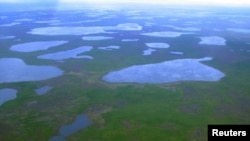A new study indicates that the accelerated melting of Arctic permafrost could release as much as 40 billion tons of carbon into the atmosphere not previously accounted for in global emissions estimates.
Permafrost is the thick layer of soil in the world's Arctic and Antarctic regions that, for centuries in some cases, has remained frozen throughout the year. It is vital to the world's climate because it stores twice as much carbon as there is in the atmosphere.
The study, published Monday in the science journal Nature Geoscience, examines how under usual circumstances, the top layer of this frozen soil thaws during summer when plants and microorganisms spring to life. The microbes eat plant roots and respirate like all living organisms and inevitably emit greenhouse gases, mostly carbon dioxide. This process is known as rhizosphere priming.
The researchers say with more and more of the prior frozen soil thawing, more plant roots are exposed to microorganisms, which in turn emit more carbon dioxide. The researchers determined the phenomenon could add as much as 40 billion tons of carbon to the atmosphere by the year 2100.
Prior to this study, scientists estimated that global emissions must fall by 7.6% every year over the next 10 years to meet the 1.5°C temperature goal of the Paris Agreement. But the authors of the study note that their new estimates of emissions from permafrost melting are currently "unaccounted for in global emission scenarios and implies that the remaining anthropogenic carbon budget to keep warming below 1.5 or 2 °C ... may need to be even more constrained."
While Earth is heating up, warming is significantly worse in the Arctic. Analysis from NASA and the U.S. National Oceanic and Atmospheric Administration suggest that the past decade was the hottest on record overall. In the Arctic, air temperatures are rising twice as fast as the global average.
This new study shows that permafrost melt can, in turn, prompt further melt. More carbon in the atmosphere means worsened atmospheric warming and more melting.








